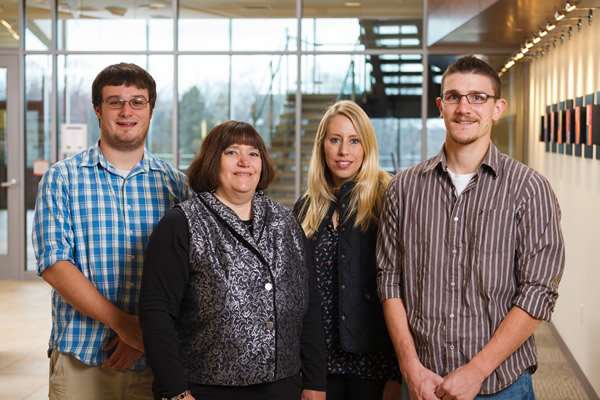
Lisa Ann Cirillo, PhD
Associate Professor; Assistant Dean for Basic Science Curriculum
Locations
- Cell Biology, Neurobiology & Anatomy
Contact Information
Education
Postdoctoral, Brown University and Fox Chase Cancer Center
Research Interests
Molecular mechanisms underlying liver development and function, with a particular focus on the role played by chromatin structure in the transcriptional regulation of liver genes.
Publications
-
(Nghiem-Rao TH, Pfeifer C, Asuncion M, Nord J, Schill D, Pulakanti K, Patel SB, Cirillo LA, Rao S.) Sci Rep. 2021 Jun 11;11(1):12386 PMID: 34117281 PMCID: PMC8196029 SCOPUS ID: 2-s2.0-85107825189 06/13/2021
-
FoxO1 and FoxA1/2 form a complex on DNA and cooperate to open chromatin at insulin-regulated genes.
(Schill D, Nord J, Cirillo LA.) Biochem Cell Biol. 2019 Apr;97(2):118-129 PMID: 30142277 08/25/2018
-
HyCCAPP as a tool to characterize promoter DNA-protein interactions in Saccharomyces cerevisiae.
(Guillen-Ahlers H, Rao PK, Levenstein ME, Kennedy-Darling J, Perumalla DS, Jadhav AY, Glenn JP, Ludwig-Kubinski A, Drigalenko E, Montoya MJ, Göring HH, Anderson CD, Scalf M, Gildersleeve HI, Cole R, Greene AM, Oduro AK, Lazarova K, Cesnik AJ, Barfknecht J, Cirillo LA, Gasch AP, Shortreed MR, Smith LM, Olivier M.) Genomics. 2016 Jun;107(6):267-73 PMID: 27184763 PMCID: PMC5017017 05/18/2016
-
(Yalley A, Schill D, Hatta M, Johnson N, Cirillo LA.) J Biol Chem. 2016 Apr 15;291(16):8848-61 PMID: 26929406 PMCID: PMC4861452 03/02/2016
-
(Mounce BC, Tsan FC, Kohler S, Cirillo LA, Tarakanova VL.) Virology. 2011 Dec 20;421(2):167-72 PMID: 22018782 PMCID: PMC3210866 SCOPUS ID: 2-s2.0-80355146848 10/25/2011
-
(Mounce BC, Tsan FC, Droit L, Kohler S, Reitsma JM, Cirillo LA, Tarakanova VL.) Virology. 2011 Nov 25;420(2):73-81 PMID: 21943826 PMCID: PMC3204369 SCOPUS ID: 2-s2.0-80054053305 09/29/2011
-
Sequence-specific capture of protein-DNA complexes for mass spectrometric protein identification.
(Wu CH, Chen S, Shortreed MR, Kreitinger GM, Yuan Y, Frey BL, Zhang Y, Mirza S, Cirillo LA, Olivier M, Smith LM.) PLoS One. 2011;6(10):e26217 PMID: 22028835 PMCID: PMC3197616 10/27/2011
-
Stable chromatin binding prevents FoxA acetylation, preserving FoxA chromatin remodeling.
(Kohler S, Cirillo LA.) J Biol Chem. 2010 Jan 01;285(1):464-72 PMID: 19897491 PMCID: PMC2804194 11/10/2009
-
Acetylation curtails nucleosome binding, not stable nucleosome remodeling, by FoxO1.
(Hatta M, Liu F, Cirillo LA.) Biochem Biophys Res Commun. 2009 Feb 20;379(4):1005-8 PMID: 19146829 01/17/2009
-
(Cirillo LA, Barton MC.) EMBO Rep. 2008 Aug;9(8):721-4 PMID: 18617889 PMCID: PMC2515216 07/12/2008
-
(Horswill MA, Narayan M, Warejcka DJ, Cirillo LA, Twining SS.) Exp Eye Res. 2008 Apr;86(4):586-600 PMID: 18291368 PMCID: PMC2374753 SCOPUS ID: 2-s2.0-41049108425 02/23/2008
-
Chromatin opening and stable perturbation of core histone:DNA contacts by FoxO1.
(Hatta M, Cirillo LA.) J Biol Chem. 2007 Dec 07;282(49):35583-93 PMID: 17923482 10/10/2007
Cirillo Lab

The long term goal of the Cirillo laboratory is to uncover fundamental mechanisms which underlie the complex patterns of gene expression required for appropriate liver development and function, with a specific emphasis on the influence of chromatin structure. A critical, unresolved issue in gene regulation is the means by which the chromatin that packages developmentally regulated genes is accessed and remodeled to orchestrate cell-type specific gene expression programs. This poses a significant dilemma in cells of both the developing embryo, in which much of the chromatin is still compacted, and the adult organism, where alterations in gene expression in response to signaling cascades directing essential physiological functions necessitate rapid alterations in the chromatin landscape. Failure to properly navigate either of these biological challenges can have grave biomedical consequences in the form of congenital malformations, disease, and neoplasia. While there is much focus in the field on chromatin remodeling and modifying enzymes, numerous studies indicate that these proteins need to be recruited to their sites of action at gene regulatory regions by initial “pioneer” DNA binding factors that are the first to engage compacted, transcriptionally silent genes in development. Current research in the Cirillo laboratory is focused on gaining a mechanistic understanding of how one such pioneer factor, the forkhead transcription factor FoxO1, uses its ability to remodel compacted chromatin and cooperate with closely juxtaposed liver-enriched transcription factors to initiate changes in chromatin structure necessary for developmental activation and hormonal modulation of target genes that dictate key metabolic processes in the human liver. Our lab has recently demonstrated that FoxO1 is able to remodel linker histone-compacted chromatin and to recruit additional liver-enriched regulatory factors and RNA polymerase II to its regulatory targets in hepatic chromatin (Hatta and Cirillo, 2007, J. Biol Chem). Intriguingly, both of these activities are significantly curtailed by posttranslational modifications linked to signaling pathways with crucial roles in maintenance of glucose, bile acid and cholesterol homeostasis in humans (Hatta et al., 2009, Biochem Biophys Res Commun). FoxO1 is a key transcriptional regulator integrating hepatic glucose, cholesterol, bile acid, and lipid metabolism in humans; we propose that the chromatin binding and remodeling capabilities attributed to FoxO1 are essential for the assembly of the nucleoprotein structures tasked with activating the corresponding genes and mediating their response to diverse signaling pathways. Subversion of these gene regulatory events is a likely contributor to metabolic derangements and hepatic disease, making it vital that we uncover the key mechanisms and players. To accomplish this, we employ a repertoire of tissue culture-based approaches, including a novel human induced pluripotent stem (hiPS) cell hepatocyte differentiation system, to uncover basic molecular mechanisms informing the function and regulation of FoxO1 under conditions that recapitulate hepatocyte specification, differentiation, and function in humans. We combine this with state of the art molecular techniques that enable the assembly and analysis of defined chromatin structures (nucleosome particles and linker histone-compacted nucleosome arrays) to test mechanisms implicated by our observations.

